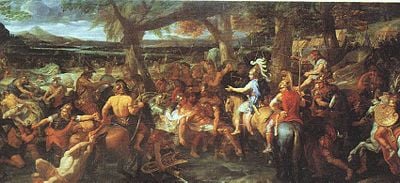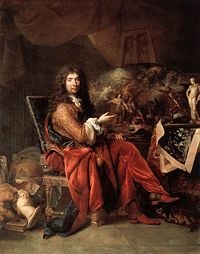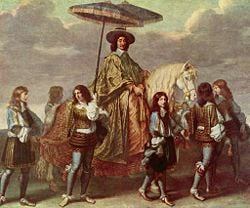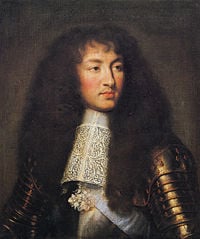Le Brun, Charles
David Doose (talk | contribs) (Epname) |
|||
| Line 5: | Line 5: | ||
Le Brun was well liked, well respected, and thus well employed by several political figures in France. These included Chancellor [[Pierre Séguier]], [[Cardinal Richelieu]] and [[Nicolas Fouquet]]. Under their directions, Le Brun was given leave to create some of the most impressive masterpieces seen in the history of France. He particularly is recognized for his brilliant and captivating [[Religion|religious]] paintings. | Le Brun was well liked, well respected, and thus well employed by several political figures in France. These included Chancellor [[Pierre Séguier]], [[Cardinal Richelieu]] and [[Nicolas Fouquet]]. Under their directions, Le Brun was given leave to create some of the most impressive masterpieces seen in the history of France. He particularly is recognized for his brilliant and captivating [[Religion|religious]] paintings. | ||
| − | However, many critics proclaim his crowning achievement the [[Palace of Versailles]]. Le Brun designed every detail of perfection of Verseailles, including the [[architecture]], decorations, and [[landscape]]. The King, [[Louis XIV]] and his chief minister [[Jean-Baptiste Colbert]] commissioned Le Brun for the endeavor, and they were not | + | However, many critics proclaim his crowning achievement the [[Palace of Versailles]]. Le Brun designed every detail of perfection of Verseailles, including the [[architecture]], decorations, and [[landscape]]. The King, [[Louis XIV]] and his chief minister [[Jean-Baptiste Colbert]] commissioned Le Brun for the endeavor, and they were not disappointed. |
| + | Charles Le Brun dominated his time like no other artist. It was hard to find his equal in France, he was esteemed as the most talented artist of his day. Many critics say that it was not until the appearance of [[Jacques-Louis David]], that artistic authority was again so concentrated in one man. | ||
| − | |||
==Early Life== | ==Early Life== | ||
[[Image:Charles Le Brun 002.jpg|thumb|250px|left|Chancellor Séguier (1660)]] | [[Image:Charles Le Brun 002.jpg|thumb|250px|left|Chancellor Séguier (1660)]] | ||
| − | |||
| − | + | Charles Le Brun was born into art. His father, a [[Paris|Parisian]] sculpture, believed that art and education were both important. So, at the young age of eleven, Le Brun was placed in the studio of [[Simon Vouet]]. This placement was the direct result of attention paid Le Brun by [[Pierre Séguier|Chancellor Séguier]]. He also studied under the direction of [[François Perrier]]. | |
| − | + | Four years later, Le Brun began receiving commissions for his work. At the young age of fifteen, Le Brun began painting for the very influential and famed people in France, [[Cardinal Richelieu]]. The Cardinal was so impressed by Le Brun's talent and ability that he received praise and laud not just from Richelieu, but other esteemed artist as well. One among them was [[Nicolas Poussin]]. In 1642, Poussin and Le Brun ventured to [[Rome]] for more in depth practice with their art. | |
| + | |||
| + | Le Brun remained in Rome for just over four years, working under Poussin. He was able to afford his lodgings and livings because of a pension he received from the chancellor, who had not forgotten the talent he helped to foster in young Le Brun. It was under this close tutelage that Le Brun was taught, influenced, and eventually adapted Poussin's art theories. | ||
| + | |||
| + | In 1646, Le Brun recognized that it was time to return home to Paris and begin his career as a painter. His education was finished, and now he would begin making a living at doing what he loved most. Once back in Paris, the work came quickly and easily. Among Le Brun's esteemed patrons was a man considered very important: [[Superintendent Fouquet]]. For Fouquet, Le Brun painted a very grand portraits of [[Anne of Austria]].<ref>{{CathEncy|wstitle=Charles Lebrun}}</ref>. The painting was large, beautiful, and helped to further Le Brun's already pristine reputation. | ||
| + | |||
| + | Le Brun went on to find employment at the chateau of [[Vaux-le-Vicomte]], just south of Paris. It was during this time that Le Brun gained the good graces of [[Mazarin]]. | ||
| + | |||
| + | |||
| + | Le Brun ingratiated himself with [[Mazarin]], then secretly pitting [[Jean-Baptiste Colbert|Colbert]] against Fouquet. Colbert also promptly recognized Le Brun's powers of organization, and attached him to his interests. Together they took control of the Academy of Painting and Sculpture (''[[Académie royale de peinture et de sculpture]]'', 1648), and the [[Academy of France at Rome]] (1666), and gave a new development to the industrial arts. | ||
==Dominant artist== | ==Dominant artist== | ||
Revision as of 23:28, 17 December 2007
Charles Le Brun (February 24, 1619 - February 22, 1690) was a true Renaissance man. The reputation he garnered for his paintings was only surpassed by his creations in architecture, both in buildings and in gardens. His place in French history is as notable as his artistic achievements. He was one of the dominant artist and art theorists of France during the 17th century.
Le Brun was well liked, well respected, and thus well employed by several political figures in France. These included Chancellor Pierre Séguier, Cardinal Richelieu and Nicolas Fouquet. Under their directions, Le Brun was given leave to create some of the most impressive masterpieces seen in the history of France. He particularly is recognized for his brilliant and captivating religious paintings.
However, many critics proclaim his crowning achievement the Palace of Versailles. Le Brun designed every detail of perfection of Verseailles, including the architecture, decorations, and landscape. The King, Louis XIV and his chief minister Jean-Baptiste Colbert commissioned Le Brun for the endeavor, and they were not disappointed.
Charles Le Brun dominated his time like no other artist. It was hard to find his equal in France, he was esteemed as the most talented artist of his day. Many critics say that it was not until the appearance of Jacques-Louis David, that artistic authority was again so concentrated in one man.
Early Life
Charles Le Brun was born into art. His father, a Parisian sculpture, believed that art and education were both important. So, at the young age of eleven, Le Brun was placed in the studio of Simon Vouet. This placement was the direct result of attention paid Le Brun by Chancellor Séguier. He also studied under the direction of François Perrier.
Four years later, Le Brun began receiving commissions for his work. At the young age of fifteen, Le Brun began painting for the very influential and famed people in France, Cardinal Richelieu. The Cardinal was so impressed by Le Brun's talent and ability that he received praise and laud not just from Richelieu, but other esteemed artist as well. One among them was Nicolas Poussin. In 1642, Poussin and Le Brun ventured to Rome for more in depth practice with their art.
Le Brun remained in Rome for just over four years, working under Poussin. He was able to afford his lodgings and livings because of a pension he received from the chancellor, who had not forgotten the talent he helped to foster in young Le Brun. It was under this close tutelage that Le Brun was taught, influenced, and eventually adapted Poussin's art theories.
In 1646, Le Brun recognized that it was time to return home to Paris and begin his career as a painter. His education was finished, and now he would begin making a living at doing what he loved most. Once back in Paris, the work came quickly and easily. Among Le Brun's esteemed patrons was a man considered very important: Superintendent Fouquet. For Fouquet, Le Brun painted a very grand portraits of Anne of Austria.[1]. The painting was large, beautiful, and helped to further Le Brun's already pristine reputation.
Le Brun went on to find employment at the chateau of Vaux-le-Vicomte, just south of Paris. It was during this time that Le Brun gained the good graces of Mazarin.
Le Brun ingratiated himself with Mazarin, then secretly pitting Colbert against Fouquet. Colbert also promptly recognized Le Brun's powers of organization, and attached him to his interests. Together they took control of the Academy of Painting and Sculpture (Académie royale de peinture et de sculpture, 1648), and the Academy of France at Rome (1666), and gave a new development to the industrial arts.
Dominant artist
In 1660 they established the Gobelins, which at first was a great school for the manufacture, not of tapestries only, but of every class of furniture required in the royal palaces. Commanding the industrial arts through the Gobelins—of which he was director—and the whole artist world through the Academy—in which he successively held every post—Le Brun imprinted his own character on all that was produced in France during his lifetime, he was the originator of Louis XIV Style and gave a direction to the national tendencies which endured centuries after his death.
The nature of his emphatic and pompous talent was in harmony with the taste of the king, who, full of admiration at the paintings by Le Brun for his triumphal entry into Paris (1660) and his decorations at the Château Vaux le Vicomte (1661), commissioned him to execute a series of subjects from the history of Alexander. The first of these, "Alexander and the Family of Darius," so delighted Louis XIV that he at once ennobled Le Brun (December, 1662), who was also created Premier Peintre du Roi (First Painter to His Majesty) with a pension of 12,000 livres, the same amount as he had yearly received in the service of the magnificent Fouquet. The King had declared him "the greatest French artist of all time."
From this date all that was done in the royal palaces was directed by Le Brun. In 1663, he became director of the Académie royale de peinture et de sculpture, where he laid the basis of academicism and became the all-powerful, peerless master of seventeenth century French art. It was during this period that he dedicated a series of works to the history of Alexander The Great ( The Battles of Alexander The Great), and he did not miss the opportunity to make a stronger connection between the magnificence of Alexander and that of the great King. While he was working on The Battles, Le Brun's style became much more personal, revealing the essence of Le Brun as he moved away from the ancient masters that influenced him.

The works of the gallery of Apollo in the Louvre were interrupted in 1677 when he accompanied the king to Flanders (on his return from Lille he painted several compositions in the Château de Saint-Germain-en-Laye), and finally - for they remained unfinished at his death - by the vast labours of Versailles, where he reserved for himself the Halls of War and Peace (Salons de la Guerreand de la Paix, 1686), the Ambassadors' Staircase, and the Great Hall of Mirrors (Galerie des Glaces, 1679–1684. Le Brun's decoration is not only a work of art, it is the definitive monument of a reign.
At the death of Colbert, François-Michel le Tellier, Marquis de Louvois, Colbert's enemy, who succeeded as superintendent in the department of public works, showed no favour to Le Brun who was Colbert's favorite, and in spite of the king's continued support Le Brun felt a bitter change in his position. This contributed to the illness which on February 22, 1690 ended in his death in his private mansion, in Paris.
Some historians have argued that Le Brun was a despot who used his power to exert artistic tyranny over the seventeenth century. This was an absurd claim with no factual documentation. It is worth pointing out that Louvois was ridiculed by the Academy when Le Brun was re-elected as director despite the minister's threats. Whenever Le Brun sensed the slightest controversy surrounding any of his positions, he resigned and gave people the chance to express their wishes in a new election, winning re-election each time. even after his death, The Academy continued to honor him; no subsequent director of the Academy received as much attention.
Le Brun primarily worked for King Louis XIV, for whom he executed large altarpieces and battle pieces. His most important paintings are at Versailles. Besides his gigantic labours at Versailles and the Louvre, the number of his works for religious corporations and private patrons is enormous. Le Brun was also a fine portraitist and an excellent draughtsman. But he was not fond of portrait or landscape painting, which he felt to be a mere exercise in developing technical prowess. What mattered was scholarly composition, whose ultimate goal was to nourish the spirit. The fundamental basis on which the director of the Academy based his art was unquestionably to make his paintings speak, through a series of symbols, costumes and gestures that allowed him subtly add to his composition the narrative elements that gave his works a particular depth. For Le Brun, a painting represented a story one could read. Nearly all his compositions have been reproduced by celebrated engravers.
Legacy
In his posthumously published treatise, Méthode pour apprendre à dessiner les passions (1668) he promoted the expression of the emotions in painting. It had much influence on art theory for the next two centuries.
Many of his drawings are in the Louvre and the Monaco Royal Collection.
Notes
- ↑ [[wikisource:Catholic Encyclopedia (1913)/Charles Lebrun "|Charles Lebrun]".] Catholic Encyclopedia. (1913). New York: Robert Appleton Company.
ReferencesISBN links support NWE through referral fees
- Morel d'Arleux, Louis-Marie-Joseph, Dissertation sur un traité de Charles Le Brun concernant le rapport de la physionomie humaine avec celle des animaux (1827)
- Pinault-Sorensen, Madeleine, De la Physionomie Humaine et Animale: Dessins de Charles Le Brun gravés pour la Chalcographie du Musée Napoleon en 1806, Musée du Louvre, (2000) (ISBN 2-7118-4094-8)
External links
- Charles Le Brun Charleslebrun.com. Retrieved December 11, 2007.
- Charles LeBrun Ibiblio.org. Retrieved December 11, 2007.
- Charles Lebrun Newadvent.org. Retrieved December 11, 2007.
- Charles Le Brun Artcyclopedia.com.
- Colantuono, Anthony. 1996. The Expression of the Passions: The Origin and Influence of Charles le Brun's "Conference sur l'expression generale et particuliere.' Findarticles.com. (Art Bulletin) Retrieved December 11, 2007.
- Tapestries Oldandsold.com. Retrieved December 11, 2007.
Warning: Default sort key "Brun, Charles Le" overrides earlier default sort key "Le Brun, Charles".
Credits
New World Encyclopedia writers and editors rewrote and completed the Wikipedia article in accordance with New World Encyclopedia standards. This article abides by terms of the Creative Commons CC-by-sa 3.0 License (CC-by-sa), which may be used and disseminated with proper attribution. Credit is due under the terms of this license that can reference both the New World Encyclopedia contributors and the selfless volunteer contributors of the Wikimedia Foundation. To cite this article click here for a list of acceptable citing formats.The history of earlier contributions by wikipedians is accessible to researchers here:
The history of this article since it was imported to New World Encyclopedia:
Note: Some restrictions may apply to use of individual images which are separately licensed.
Retrieved December 11, 2007.


